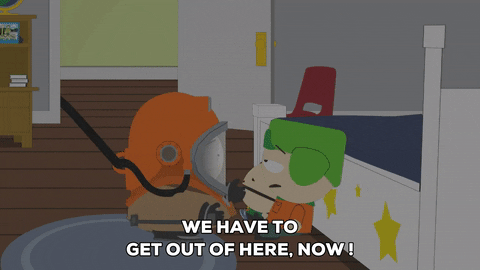Talent Sourcing is a key part of any good recruitment strategy. This usually entails proactively engaging with potential candidates through marketing, networking or targeted outreach.
With the job market being somewhat unpredictable (especially in the tech sector), many companies are changing how they recruit, some opting for a traditional post it and they will apply model (aka the Talent Surplus model) with others doubling down on proactive outreach and selection (aka Talent Scarcity model).
As a Job Seeker - why should you care?
Knowing where you are in your job seeking journey, as well as how some companies can view folks at the different stages can help optimise your strategy and find the next job more effectively.
Let’s dive in.
Stage One: Not Looking or Interested.
Pretty straightforward category. These are folks who are very happy with their current role and company. The only way you’d be tempted into a conversation is for more money… and a lot more usually!
About 28% of people fall into this category.
Recruiter Advice:
Always be open to conversations about other roles.
Even if it’s not of interest or a match for you, you may know someone in your network who could be looking.
Also, that recruiter or hiring manager you’ve spent time with may have other opportunities you are actually interested in in the future. You never know!
Stage Two: Not Looking, but Talk To Me.
These folks are happy and content with their current role, but also open to a potential change. Perhaps they’ve been in their current company for a while or can see a limit to their growth in the future. Whatever the reason, folks in this stage are willing to listen to new opportunities, but are also not actively in the job hunt.
About 40% of people fall into this category.
Recruiter Advice:
This is a great space to be in, especially if you have a clear understanding of what you would need from your next opportunity.
Don’t make it all about compensation! While compensation is of course important, consider other factors (like the product, culture, growth trajectory etc.) when evaluating things.
Sourcing strategies are generally trying to target these folks, which gives credence to the old saying “it’s easier to find a job when you have a job”
Stage Three: It Might Be Time To Call It.
People enter this stage when they recognise there could be better career options out in the market. For many, it correlates with tenure at a company and starting to feel bored, slightly undervalued or underpaid.
At this stage you may start reaching out to friends or co-workers to get their advice, or insight into potential companies. Your search is pretty low-key (no LinkedIn or social media posts yet).
About 15% of people fall into this category.
Recruiter Advice:
If you are in Stage Three, it’s a great time to prep your CV and LinkedIn profiles while you still have access to a lot of the data points and project materials from your current role.
Not that you would share confidential information, but tangible data points can help your achievements stand out on a CV.
Connecting with former co-workers in your area of interest is a great first step. You’re not hurting for a new role yet, so you have the luxury of doing lots of due diligence on target companies before applying.
Let trusted friends and colleague know you’re considering new opportunities - referrals can really help you leapfrog some of the competition if you do see a role that you want to apply for.
Stage Four: That’s it, it’s time to go.
When you’ve had enough of your current role or company and start to google [job title x” jobs], congratulations. You’ve passed into Stage Four.
People at this stage are looking for a good job i.e a promotion or a step up in their career. They are unlikely to accept or apply for roles that are at the same level.
About 5% of people fall into this category.
Recruiter Advice:
Evaluate what you are running away from and what you want to run towards. It will likely be a common question recruiters ask about.
Continue to network, referrals can be key. Don’t stop at your current network, start reaching out to others in the space, in your target roles or working at target companies.
Start thinking about customising your resume for the types of roles or companies you are interested in applying for.
Stage Five: Get Out of Here Now!
People in this category can see the dark clouds of negative culture shifts, poor company performance or the dreaded lay-offs coming over the hill. If you were jogging out the door, now you’re ready to sprint.
The biggest difference between stages three and four is willingness to connect with others outside of your direct network and acceptance of so called lateral moves (accepting a role of similar seniority, scope etc).
Given the upheaval at their current role, folks may be searching for longer term stability versus the hot new start up (although not always the case). About 4% of people fall into this category.
Recruiter Advice:
Be consistent and apply. Don’t get hung up on don’t all the extra things for each application. Sometimes, you should just throw your name into the hat.
Any response or interview can be seen as practice, even if you aren’t 1000% interested in that role.
Make sure you have a strong CV (customised for the role).
For roles you are really excited about, you can tweak your application further, follow up with hiring teams etc. but don’t
Don’t sweat the no’s or no response.
The market can be crazy, sometimes you don’t hear back. Many times this isn’t a reflection of your ability or your application.
Stage Six: The Hunters.
The final stage is people who are actively looking. You may be in a completely sub-par position you need to get out of, or you are out of work.
Whatever the case you are looking for something different that pays the bills and gets you out of your current situation.
About 8% of people fall into this category.
Recruiter Advice:
All the previous advice still applies;
Reach out to colleagues and friends.
Network with professionals in your field and/or recruiters in the space.
Customise your CV and start applying.
In interviews, remember to think about why you want to work at the specific company and role you are applying for;
All companies like to feel special - avoid saying you just applied or you just need a job (that may be the case but they likely will prefer a more polished answer).
Job seeking is hard at the best of times, sometimes you just need to get out of a toxic situation or get some money coming in the door. Don’t beat yourself up if you don’t hear back.
And Finally…
Unfortunately, bias is a thing. You may have to work a bit harder to show your value in stage five vs. stage one.
However, no matter what stage you are in, your value as a candidate does not change. Knowing how to play your hand in the right way can make all the difference.









